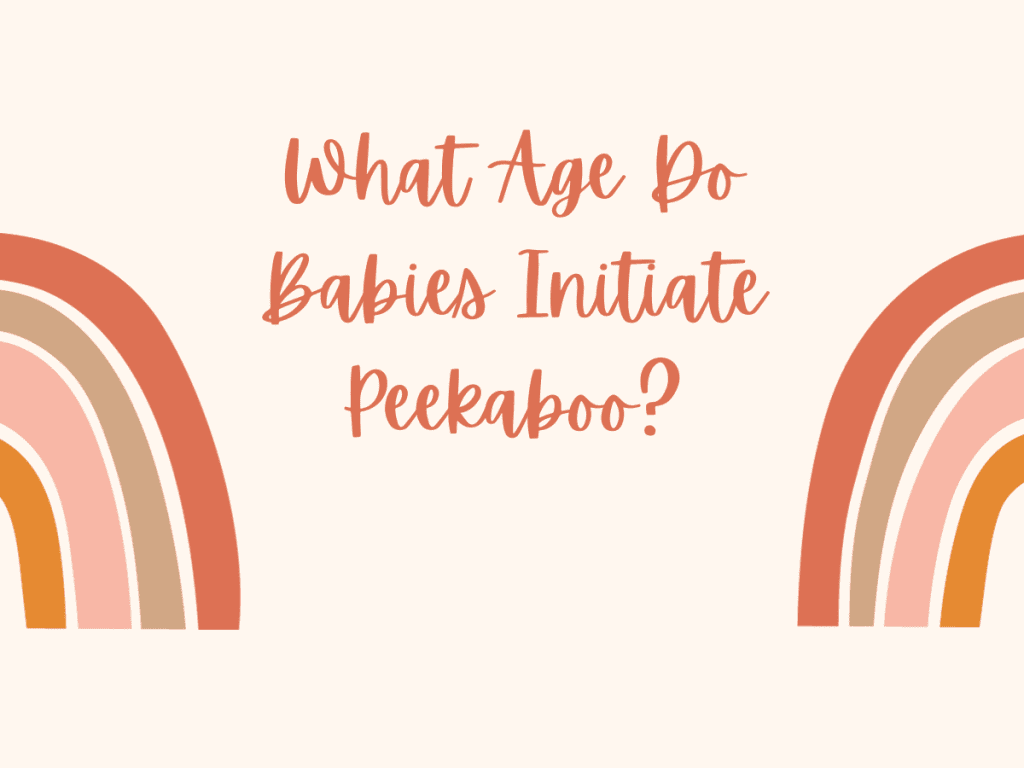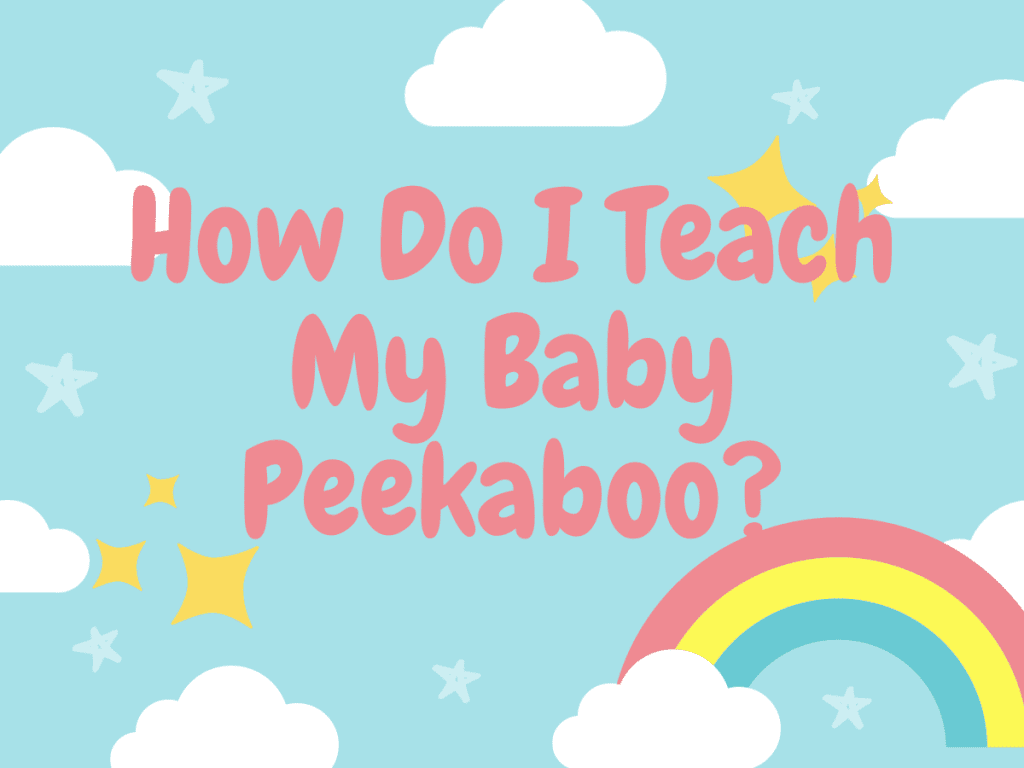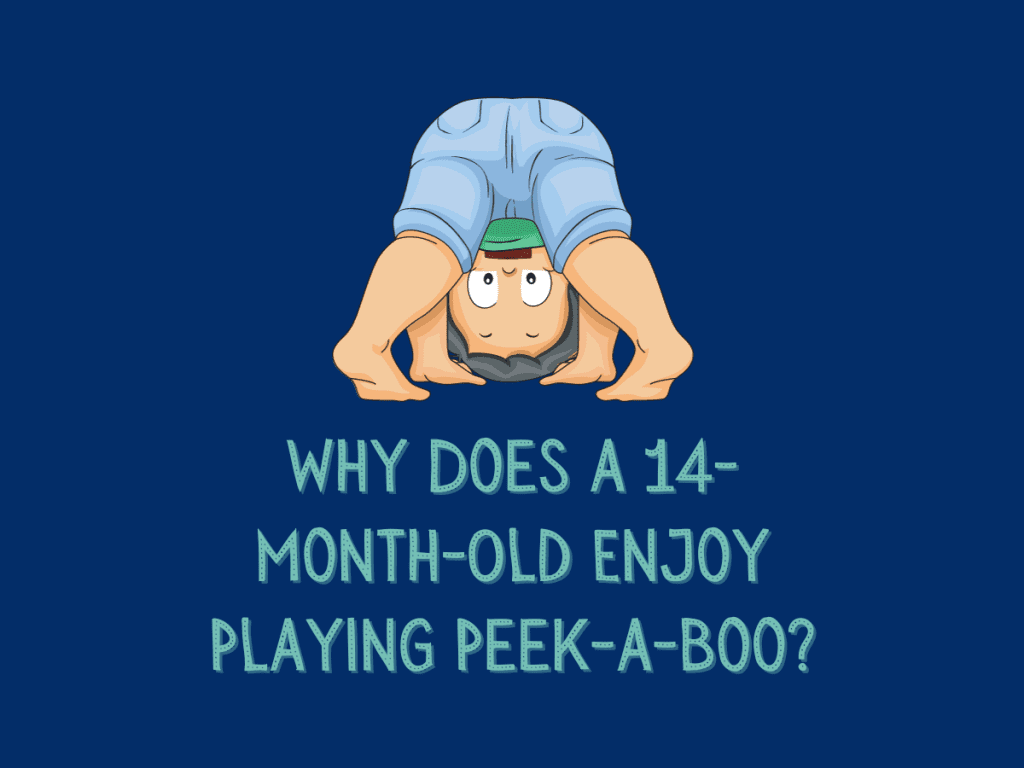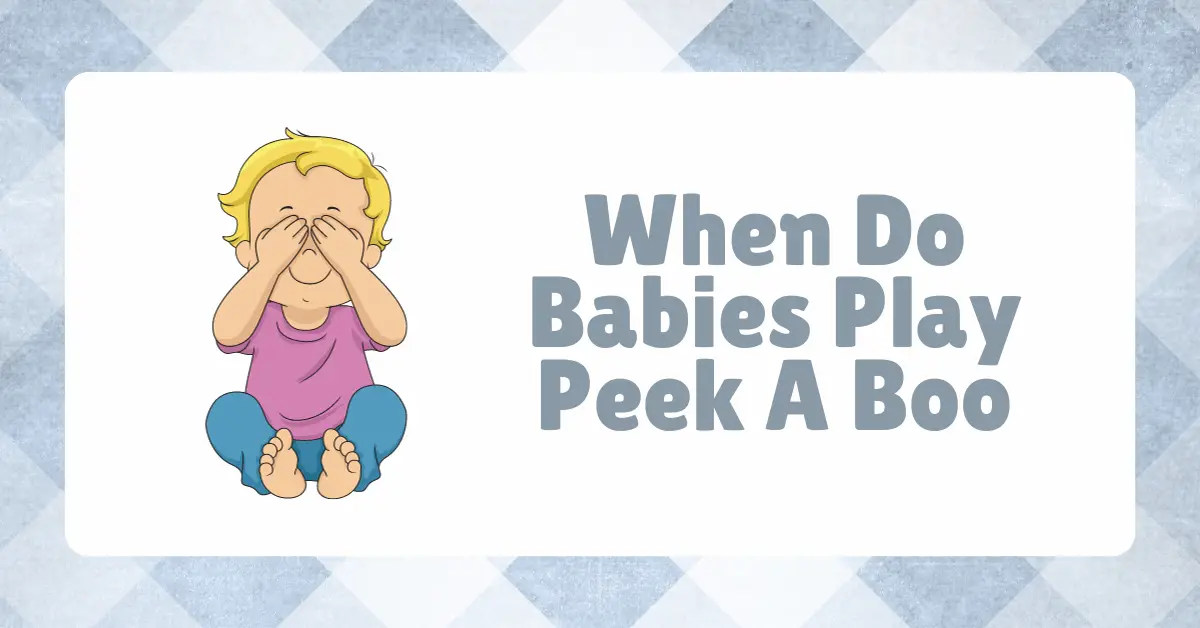This was a question we wondered when we had our first, when do babies play peek-a-boo? Peek-a-boo is a classic favourite and becomes a central part of your child’s playtime between 3 to 9 months of age. By 3-4 months your baby will begin to laugh out loud and enjoy you playing peek a boo with them. By 8 to 9 months of age, they will understand object permeance and in the 9 to 12-month range will be able to play peek a boo entirely on their own.
As babies develop, their response to the game deepens, offering them not just entertainment, but also vital lessons in cognitive and social development. This article will explore the intricacies of peek-a-boo, shedding light on its significance in a child’s life.
There is nothing better than playing peek-a-boo for the first time with your baby. The laughs, smiles, and curiosity are absolutely adorable. It has been a favourite milestone of mine with all three of our boys.
When Do Babies Play Peek-a-Boo On Their Own?
Peek-a-boo is not only a source of endless fun but also an indicator of certain developmental milestones. Over the months, as your baby matures, you might notice them showing interest in playing the game without your initiation.
The age range and developmental cues indicating a baby’s readiness:
Typically, around the 6-9 months mark, babies begin to grasp the concept of object permanence, which is fundamental to the game of peek-a-boo. This understanding means they’re starting to realize that just because something is out of sight, it doesn’t mean it’s gone forever. When a baby starts trying to hide their own face or a stuffed toy and then reveals it, that’s a sign they’re beginning to engage with the game independently.
Importance of self-initiated play:
Self-initiated play, like playing peek-a-boo on their own, is crucial for a baby’s development. It enhances their cognitive development, boosts their confidence, and allows them to explore the world at their own pace and in their own way. It gives them a sense of agency and control, fostering decision-making skills and promoting independent thinking.

What Age Do Babies Initiate Peekaboo?
Understanding when babies move from merely responding to peek-a-boo to initiating it themselves can be an exciting phase for parents and caregivers.
Differences between passive engagement and active initiation:
Passive engagement is when babies react to someone else starting the game, like laughing when you hide and reveal your face. Active initiation, on the other hand, is when they decide to start the game themselves, perhaps by hiding their face with their hands or using a cloth, then revealing their face with evident anticipation of your reaction.
Signs that your baby is starting to initiate the game:
- Anticipatory Giggles: Before they even hide or reveal their face, they might start giggling, showing they expect a reaction.
- Mimicking Movements: If they’ve seen you play the game several times, they might try to imitate the hand movements or facial expressions you make during the game.
- Using Props: They might pick up a blanket or a favourite toy and use it to hide their face, waiting for your reaction once they reveal themselves.
- Engaging Others: Your baby might try to play peek-a-boo with other family members or even with their stuffed toys, indicating a clear understanding of the game’s mechanics.
Observing these milestones and recognizing the shift from passive engagement to active initiation provides insight into your baby’s cognitive and social development. It’s not just about the game; it’s about their growing understanding of the world around them and their evolving place within it.
How to Play Peek-a-Boo
Peek-a-boo is a cherished classic game that resonates with babies of all ages. It’s a fantastic way to elicit joyful giggles from a baby’s face and also serves as a foundational activity for their development. Here’s how to introduce and enjoy this game with your little one:
Basic steps for parents and caregivers:
- Positioning: Sit facing your baby, ensuring that you’re at their eye level. This encourages eye contact and strengthens the social interaction aspect of the game. If your baby is still in the early months, tummy time is a great way to engage them in peek-a-boo while also bolstering their gross motor skills.
- Hiding: Using your hands, a soft cloth, or even a favourite stuffed toy, hide your face from the baby’s view. Say “Where’s [Your Name]?” or simply “Where am I?” to pique their curiosity.
- Reveal: After a brief pause, quickly reveal your smiling face with a cheerful “Peek-a-boo!” or “Here I am!” This element of surprise, paired with a familiar face, will often make your baby laugh and delight in the repetition.
- Engage and Respond: If your baby tries to hide their own face or imitate your hand movements, cheer them on! Celebrate their attempts, as this mirrors their understanding of the game and their growing social skills.
Different variations of the game to keep it engaging:
- Toy Peek-a-Boo: Use your baby’s favourite toys to hide and reveal, strengthening their object recognition skills. A stuffed toy or a soft cloth can be a fun twist, and the familiar object will often make the game even more enjoyable.
- Mirror Play: Sit with your baby in front of a mirror, and use it to play peek-a-boo. This introduces a new dimension and can be particularly fascinating for babies as they see their own faces disappear and reappear.
- Vocal Variations: Change the tone, pitch, or language of your “Peek-a-boo!” shout. This can be a great way to introduce new sounds and tones, aiding in their language development.
- Peek-a-Boo with Siblings or Play Partners: Engage older siblings or play partners in the game. The more faces and variations, the more stimulating it becomes for the baby. It’s also a great game to teach turn-taking and understanding the concept of waiting.
Remember, the essence of peek-a-boo lies in its simplicity. It’s a game that requires no fancy tools or setups. The primary aim is to enjoy the shared moments, see that happy face light up with surprise, and embrace the countless developmental benefits it offers. Whether it’s the early months of age or moving towards the 6-9 months phase, peek-a-boo remains a versatile and invaluable tool in a child’s early years.

How Do I Teach My Baby Peekaboo?
Introducing your baby to peek-a-boo is a delightful experience. Here’s a step-by-step guide to make the learning process as enjoyable as the game itself.
Step-by-step guidance for parents:
- Start Simple: Initially, use your hands to cover your face. As you hide, ask, “Where am I?” or “Where’s [Your Name]?” Then reveal your face with a bright “Peek-a-boo!”
- Engage With Eye Contact: Make sure to maintain eye contact when you reveal your face, as this strengthens the social interaction aspect of the game.
- Use Props: Once your baby is familiar with the basic version, introduce props like blankets, soft cloths, or their favorite toys to add variety.
- Encourage Imitation: If your baby shows interest in imitating you, celebrate and encourage it. It’s their way of understanding and engaging with the game.
- Take Turns: As your baby becomes more adept, take turns being the “hider” and the “seeker.” This not only makes the game more interactive but also teaches the concept of turn-taking.
Tips to make the learning process enjoyable:
- Stay Expressive: Amplify your facial expressions. A wide-eyed surprise or a big smile can make the reveal even more exciting for your baby.
- Vary Your Voice: Use different tones, pitches, or even sing-songy variations of “Peek-a-boo” to keep the game fresh and engaging.
- Celebrate Their Attempts: If your baby tries to play or imitate, even if not perfectly, cheer and applaud their efforts.
- Keep It Light: Remember, the goal is to have fun. If your baby seems uninterested or fussy, it’s okay to take a break and come back to the game later.
Peek-a-boo, in its essence, is about connection, learning, and joy. With these guidelines, you’re set to introduce your baby to a world of laughter and valuable lessons.
What Babies Learn from Peek-a-Boo
Peek-a-boo, while seemingly a simple and playful activity, is a treasure trove of learning opportunities for babies. From the smiles and giggles, babies are picking up critical skills that will serve as foundations for their future learning and interactions.
Cognitive benefits:
- Understanding Object Permanence: One of the most significant cognitive benefits derived from peek-a-boo is the understanding of object permanence. As babies realize that the hidden face or object still exists even when it’s out of sight, they begin to grasp this fundamental concept.
- Cause and Effect: Peek-a-boo also teaches babies about cause and effect. They learn that certain actions, like uncovering their face or the face of a caregiver, lead to specific reactions, such as laughter or expressions of surprise.
Social benefits:
- Interaction: The game is rooted in social interaction. Babies learn to engage with others, understanding the dynamics of back-and-forth play.
- Turn-Taking: As the game progresses and babies become more active participants, they start to understand the concept of turn-taking, a crucial social skill for group interactions later in life.
- Bonding: Peek-a-boo is a shared activity that strengthens the bond between the baby and the caregiver. The repeated cycles of hide-and-reveal, paired with the reactions it elicits, foster trust and deepen emotional connections.
Is Playing Peek-a-Boo a Cognitive Skill?
At first glance, peek-a-boo might seem like just another playful activity. However, when we dive deeper, it’s evident that this game is rich in cognitive processes.
Exploration of the cognitive processes involved:
- Anticipation: The element of surprise in peek-a-boo requires babies to anticipate what comes next. This anticipation builds neural pathways and sharpens their predictive abilities.
- Memory: As babies play the game repeatedly, they start to remember the sequence and outcomes, strengthening their memory skills.
- Problem Solving: When babies become active participants, trying to uncover the hidden face or object, they engage in basic problem-solving, figuring out how to achieve the desired reveal.
Connection with other major developmental milestones:
Peek-a-boo, with its cognitive and social benefits, aligns with several major developmental milestones. For instance, the understanding of object permanence paves the way for more complex cognitive tasks like spatial reasoning. Similarly, the social interactions fostered by peek-a-boo lay the groundwork for more advanced social skills, such as empathy and cooperative play.
In conclusion, peek-a-boo, while playful and entertaining, is a potent tool for cognitive and social development. Each game session, filled with laughter and joy, is a step forward in a baby’s developmental journey.

Why Does a 14-Month-Old Enjoy Playing Peek-a-Boo?
By the age of 14 months, babies have undergone significant cognitive and emotional growth, making games like peek-a-boo even more enjoyable and relevant to them.
Cognitive and emotional reasons:
- Understanding of Object Permanence: At this age, babies have a clearer grasp of the concept of object permanence. When they see a face or toy disappear and then reappear, it reinforces their understanding that objects continue to exist even when out of sight.
- Emotional Connections: The familiar face, be it of a parent, caregiver, or sibling, provides comfort and security. The brief moment of “disappearance” followed by the “reappearance” can be emotionally stimulating, as it mirrors the baby’s experiences of separations and reunions in their daily life.
The role of anticipation and surprise at this age:
Anticipation and surprise are powerful tools for a 14-month-old. Their growing memory allows them to recall past games, building a sense of anticipation each time the game starts. This anticipation, combined with the element of surprise, triggers joy, laughter, and excitement. Each round of peek-a-boo becomes a delightful cycle of predictability and unexpectedness, a balance that 14-month-olds find particularly captivating.
Wrapping Up When Babies Play Peek A Boo
Peek-a-boo is more than just a playful pastime. This timeless game, rich in history and embraced by cultures worldwide, serves as a pivotal tool in a child’s developmental journey. From understanding complex cognitive concepts like object permanence to building foundational social skills, peek-a-boo offers a multifaceted learning experience. Parents and caregivers play a pivotal role in this process, turning each game session into an opportunity for growth, bonding, and joyous memories. As we uncover the many layers of peek-a-boo, it becomes evident that behind every giggle, there’s a world of learning and exploration unfolding for our little ones.

